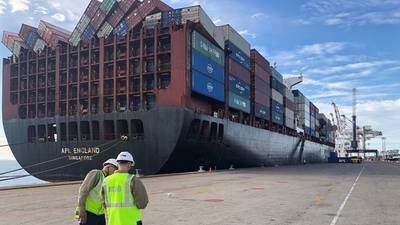ATSB Publishes Preliminary Report on APL England Incident
A preliminary investigation report published by the Australian Transport Safety Bureau (ATSB) details that a containership was rolling and pitching heavily in rough seas and high winds when it lost 50 containers overboard about 46 nautical miles south-east of Sydney in May 2020.
The ongoing investigation’s preliminary report sets out the incident’s sequence of events and outlines that as the APL England travelled down the east coast of Australia, the Bureau of Meteorology issued regular forecasts regarding a complex low pressure system developing off the south-east of the country, with gale force wind warnings.
“By 0600 on Sunday, May 24, while maintaining a southerly course and a speed of about 7 knots, the ship was pitching and periodically rolling in high seas and gale force winds,” said ATSB Chief Commissioner Greg Hood.
“Shortly after, at 0610, the ship experienced a series of very heavy rolls, to about 25° either side of upright. On the bridge, with many items moving and falling to the deck and the crew holding on to maintain their footing, steering system and engine room alarms sounded, and then the main engine shut down due to a loss of oil pressure.”
The report details that the crew restarted the engine, by which time the ship had turned to port, beam on to the seas, while continuing to roll heavily. The ship slowly gathered speed, and was turned easterly and then southerly, into the weather, before the crew then decided to head north, with the weather.
“It was not until skies had lightened—sunrise was at 0647—that the chief officer first noticed the fallen stacks of containers,” Hood noted.
“It was later established that 50 containers had been lost overboard from both forward and aft bays. One container lost overboard contained hazardous goods in the form of dry powder fire extinguishers, while 23 containers were empty. A further 63 containers were damaged but remained on board.”
The ship would recover to the Port of Brisbane, where ATSB transport safety investigators were able to board the vessel to survey the damaged container stacks, inspect the container lashing equipment, download the vessel data recorder and video recording system, and interview the crew.
“Generally, the ship’s lashing equipment appeared in good condition. However, many of the ship fittings including lashing eyes, lashing bridges and deck structures were found to be heavily corroded and wasted,” Hood said.
In addition, ATSB examination of the container stowage arrangement showed that the use of ‘high cube’ (2.9m/9ft 6in high) as opposed to standard height (2.6m/8ft 6in) containers in the ship’s aft-most container bay, bay 62, affected the security of the stow above the container cell guides. However, the loading computer’s lashing and forces checks did not show any conflicts for this arrangement.
Hood noted that the preliminary report does not include any safety findings or analysis, which will be detailed in the final report.
“The ongoing investigation will review and analyze several areas of interest including the ship’s container stow and lashing arrangement; the maintenance regimes for the ship’s deck and engine room; the ship’s service and inspection history; the ship’s stability condition; weather conditions and information provided to crew; and the actions of the ship’s crew,” he said.
A final report will be released at the conclusion of the investigation.
“However, should a critical safety issue be identified during the investigation, the ATSB will immediately notify relevant parties so appropriate and timely safety action can be taken,” Hood concluded.












